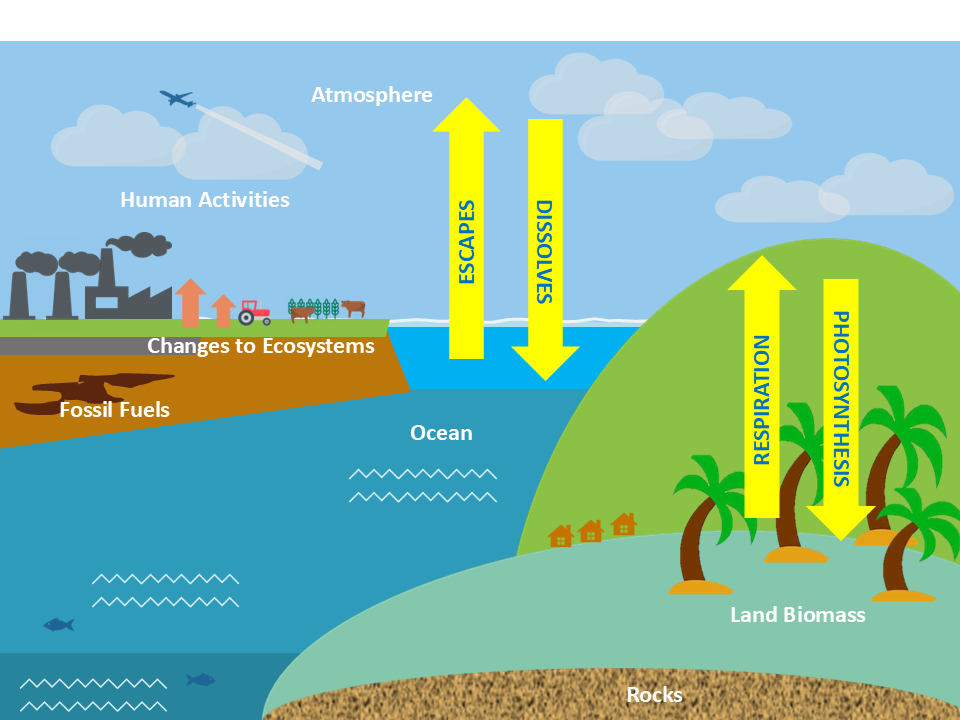Pick Up
1228. Climate and Carbon Cycle Feedback Interactions May Significantly Accelerate Global Warming

1228. Climate and Carbon Cycle Feedback Interactions May Significantly Accelerate Global Warming
Due to efforts to decarbonize the global economy, global anthropogenic emissions are diverging from the most extreme emission scenarios. Meanwhile, a paper published in Environmental Research Letters made long-term predictions for the next 1,000 years and pointed out that taking into account climate and carbon cycle feedback loops, including melting permafrost, could lead to a temperature rise significantly above the 2°C threshold.
Uncertainties in anthropogenic climate change projections are primarily due to future emission scenarios and climate sensitivity. The latter is determined by the strength of several climate feedbacks, but there is a large uncertainty. For this reason, it is considered crucial for climate science to constrain the Earth's equilibrium climate sensitivity (ECS), defined as the change in steady-state global mean surface temperature due to a doubling of atmospheric CO2. As high emission pathways are no longer consistent with current emission trends, it is necessary to investigate uncertainties related to climate sensitivity, carbon cycle feedbacks, and tipping points in realistic scenarios under warm climate conditions.
Across a range of scenarios, when the Earth's ECS is high, the overall carbon cycle feedback was found to be responsible for nearly half of the additional temperature rise. In other words, the carbon cycle feedback is as important as the change in climate sensitivity. The additional temperature change due to the carbon cycle feedback can be further decomposed into the contributions of CO2 and CH4, with the impact of CO2 on temperature being larger than that of CH4 in all scenarios.
Temperature changes are consistently larger in high latitudes, and the increase in warming in high latitudes is mainly due to polar amplification caused by the reduction of sea ice and snow (surface albedo feedback) and the trapping of warming at the surface (positive lapse rate feedback). By 2300, warming will progress in Arctic Ocean regions with retreating sea ice margins, such as the Greenland Sea and the Barents-Kara Sea, and Arctic temperatures are expected to increase by an average of about 4°C by 2300, and by 11°C to a maximum of about 15°C depending on the scenario and region.
On the other hand, the response of the terrestrial carbon cycle to climate change is mainly controlled by two opposing feedback mechanisms. The first is the CO2 fertilization effect, which increases terrestrial carbon uptake. This is because high CO2 concentrations stimulate plants to consume more carbon through photosynthesis (negative feedback of terrestrial CO2-carbon cycle). The second is warming-stimulated soil respiration, which occurs when land carbon uptake decreases and increased microbial activity releases CO2 from soils (positive feedback of terrestrial climate-carbon cycle). The positive feedback of the carbon cycle as a whole (including the oceans) is driven mainly by the land carbon response via the temperature dependence of soil respiration. Different ECSs greatly affect the amount of carbon stored in soils, with larger ECSs resulting in less soil carbon. Meanwhile, changes in vegetation carbon are small and driven by changes in net primary production. Simulations suggest that as ECS increases, the positive feedback of the climate-carbon cycle becomes more dominant than the negative feedback of the CO2-carbon cycle.
Historically (1850-2015), land use changes have reduced vegetation carbon and increased soil carbon. In the 21st century, land will become a net carbon sink due to increased net primary productivity. Although the increase in vegetation carbon in the 21st century is scenario-dependent, ECS plays a large role in determining the magnitude of these changes. Globally, soil carbon initially increases across the different scenarios, peaking earlier under high ECS values, followed by a rapid decline, resulting in soil carbon stocks being either a net source (high ECS) or a net sink (low ECS) depending on the climate sensitivity. Most of the positive feedback to the terrestrial carbon cycle can be attributed to changes in carbon stored in permafrost. In high ECS simulations, more than 50% (61%-94%) of permafrost area is lost, with most of the retained carbon being released to the atmosphere. In low ECS simulations, permafrost area decreases, but carbon losses in soils are mitigated to some extent by increased net primary production and the resulting increased carbon input to soils. In other words, land is likely to be a net source (sink) of CO2 over the next millennium at higher (lower) ECSs.
The positive climate-CH4 feedback arises from the temperature dependence of simulated natural CH4 emissions, since the proportion of total soil carbon respired as CH4 from wetlands increases with temperature. Natural CH4 emissions are clearly dominated by tropical regions, with the subtropics playing a secondary role.
The ocean acts as a carbon sink in all simulations, and the ocean carbon response is very similar at various ECS levels. This is explained by the fact that the effects of climate change (positive ocean climate-carbon cycle feedback) and atmospheric CO2 concentration changes (negative ocean CO2-carbon cycle feedback) on the atmosphere-ocean carbon exchange are almost offset.
In light of the above, intensifying research into the linkages between climate sensitivity, carbon cycle feedbacks, and tipping points in realistic scenarios, even under warm climate conditions, will contribute to mitigating uncertainties in future climate change.
(Reference)
Christine Kaufhold et al. Interplay between climate and carbon cycle feedbacks could substantially enhance future warming, Environmental Research Letters (2025). https://iopscience.iop.org/article/10.1088/1748-9326/adb6be
Contributor: IIYAMA Miyuki, Information Program
